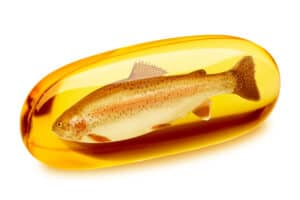Share this post
Supplemental DHA may improve fertility
Infertility is an increasing problem, especially among women in their 30’s or 40’s.[1],[2] Fortunately, diet and nutrition can help those seeking to become pregnant.[3],[4]
Remarkably, a recent study suggests that supplementation with omega-3 fatty acids (“omega-3s”) may improve the chance of natural conception in women aged 30 to 44 years.[5]
Omega-3s – including eicosapentaenoic acid (EPA) and docosahexaenoic acid (DHA), which are very long chain fatty acids – are essential for good health at all stages of life, from fetal development to the golden years.[6],[7],[8],[9],[10]
In the May 2022 study, scientists looked at the effects of omega-3 fatty acid supplementation on the probability of achieving a pregnancy within one menstrual cycle.[5]
The authors’ analysis of 2,510 menstrual cycles in 900 women showed that individuals taking omega-3 supplements were significantly more likely to conceive (84.9%) compared to those not taking omega-3s (51.9%).[5] The researchers took pains to tease out the effects of other fertility-related factors such as age, body weight, and the use of prenatal vitamins, multivitamins, or vitamin D, and found that omega-3 supplementation still had a positive effect.
Individuals taking omega-3 supplements were significantly more likely to conceive (84.9%) compared to those not taking omega-3s (51.9%).
“Our data suggest omega-3 supplementation may increase the probability of a woman conceiving,” say the authors. “Omega-3 supplementation may present a feasible and inexpensive modifiable factor to improve fertility.”[5]
Omega-3 fatty acids are also important for in vitro fertilization (IVF)
The above study relates to natural conception, but omega-3’s may also be useful for couples seeking assisted reproductive technologies as well. According to studies done at Harvard University, higher blood levels of omega-3s are associated with a greater likelihood of pregnancy in couples undergoing in vitro fertilization (IVF).[11],[12]
These and other studies suggest that omega-3 supplementation may improve reproductive success in a simple, effective, and very safe way.[13],[14],[15]
Omega-3 supplementation supports a healthy pregnancy
Approximately 285 mg/day of DHA reduced the risk of preterm births and very low body weight babies by nearly 50%.
Prenatal supplements paired with omega-3s – in particular, DHA – may significantly reduce the risk of preterm birth (i.e., birth at less than 34 weeks’ gestation).[16],[17],[18] Since preterm babies can have many health problems, the potential ability of DHA to reduce this risk is highly significant.
In one randomized controlled clinical trial, pregnant women were assigned to consume either three daily capsules of 200 mg DHA (for a total daily dose of 600 mg) or three daily capsules of vegetable oil without DHA (control group).[19] Approximately 50% compliance (equivalent to about 10 capsules/week or ~285 mg/day of DHA) reduced the risk of preterm births and very low body weight babies by nearly 50%. Higher omega-3 intakes, up to 600 mg/day, reduced these risks even further.[19]
Omega-3 fatty acids support fetal brain development
An adequate supply of DHA throughout pregnancy is crucial for fetal brain development.[20] DHA is the preferred dietary omega-3 fatty acid for the development of the brain and retina, so a growing fetus has a high requirement for DHA.
An expecting mother’s intake of omega-3s may even impact her child’s cognition and behavior in infancy, toddlerhood, and childhood.[20],[21],[22],[23],[24] A 2022 study showed that higher omega-3 intakes during the first trimester of pregnancy were associated with better cognitive scores in children at four and seven years of age.[25] These and other studies highlight the importance of DHA for expectant moms.
How much DHA and EPA do we need?
Numerous studies suggest that healthy adults should consume 250–500 mg/day of omega-3s (DHA plus EPA).[20],[26],[27],[28] Unfortunately, few Americans achieve these levels.[26],[27],[29],[30]
Regarding pregnancy, the main conclusions of expert scientific groups are as follows:
- Women of childbearing age should aim to consume two to three four-ounce portions of seafood per week, especially salmon.[31],[32]
- Shrimp should not be relied on to supply DHA, as it is relatively low in omega-3s.[21]
- Avoid fish with high levels of mercury, such as swordfish and some types of tuna.[33] See the FDA website for a downloadable chart showing the mercury levels in different kinds of fish.[34]
- Omega-3 fatty acid and DHA supplements are a safe choice for pregnant women. Unlike seafood, purified supplements do not contain mercury.[35]
- Pregnant women may have insufficient intakes of DHA unless they take supplements.[21],[26],[31],[36],[37]
- Pregnant and lactating women should consume at least 200 mg/day of DHA.[31]
- Intakes of up to 1 gram/day of DHA (or 2.7 grams/day of total omega-3s) are considered safe.[31],[38]
- To ensure adequate absorption, it is important to take omega-3 supplements with a meal containing some fat.[39]
Omega-3s are also important for men
Nearly half of all infertility cases are due to male factors, so adequate nutrition is as important for men as it is for women.[40]
A man’s intake of omega-3s has been shown to correlate with his sperm numbers and sperm motility, factors that influence fertility.12,[41],[42],[43] In fact, a 2020 study showed that men who took fish oil supplements for at least 60 days within a 90-day period had on average 64% greater semen volumes than those who did not take omega-3s.43
Research also suggests that sufficient levels of antioxidants, such as melatonin and CoQ10, may enhance fertility for men who wish to become fathers.[41],[44],[45],[46],[47]
Conclusions
Women should be sure to consume sufficient omega‐3 fatty acids, especially DHA, before and during pregnancy and lactation.
Because nutrition is so important for conception and for a healthy pregnancy, it’s a good idea to focus on nutrition and consult a healthcare professional – ideally before becoming pregnant.[48],[49]
Women should be sure to consume sufficient omega‐3 fatty acids, especially DHA, before and during pregnancy and lactation.[44] Many other nutrients are also crucial for a healthy pregnancy, including folic acid, vitamin B12, iron, calcium, vitamin D, and iodine.[48],[49],[50]
If you enjoyed this article, you may also be interested in the following posts:
- Are You Getting Enough DHA? Docosahexaenoic acid for brain and eye health.
- Nutritional Factors in Female Fertility: Part 1 and Part 2.
- The Forgotten Man: Male infertility and its causes.
Click here to see References
[1] Chandra A, et al. Infertility and impaired fecundity in the United States, 1982-2010: data from the National Survey of Family Growth. Natl Health Stat Report. 2013 Aug 14;(67):1-18.
[2] Centers for Disease Control and Prevention (CDC). Reproductive Health: Infertility FAQs [Internet]. Atlanta (GA): Centers for Disease Control and Prevention; 2022 [cited 2022 May 18]. Available from: http://www.cdc.gov/reproductivehealth/Infertility
[3] Silvestris E, et al. Nutrition and female fertility: an interdependent correlation. Front Endocrinol (Lausanne). 2019 Jun 7;10:346.
[4] Montagnoli C, et al. Maternal periconceptional nutrition matters. A scoping review of the current literature. J Matern Fetal Neonatal Med. 2021 Aug 15;1-18.
[5] Stanhiser J, et al. Omega-3 fatty acid supplementation and fecundability. Hum Reprod. 2022 May 3;37(5):1037-46.
[6] Politano CA, López-Berroa J. Omega-3 fatty acids and fecundation, pregnancy and breastfeeding. Rev Bras Ginecol Obstet. 2020 Mar;42(3):160-4.
[7] Simopoulos AP. The importance of the omega-6/omega-3 fatty acid ratio in cardiovascular disease and other chronic diseases. Exp Biol Med (Maywood). 2008 Jun;233(6):674-88.
[8] Fard SG, et al. How does high DHA fish oil affect health? A systematic review of evidence. Crit Rev Food Sci Nutr. 2019;59(11):1684-727.
[9] Wathes DC, et al. Polyunsaturated fatty acids in male and female reproduction. Biol Reprod. 2007 Aug;77(2):190-201.
[10] Hu Y, et al. Marine omega-3 supplementation and cardiovascular disease: an updated meta-analysis of 13 randomized controlled trials involving 127,477 participants. J Am Heart Assoc. 2019 Oct;8(19):e013543.
[11] Chiu Y-H, et al. Serum omega-3 fatty acids and treatment outcomes among women undergoing assisted reproduction. Hum Reprod. 2018 Jan 1;33(1):156-65.
[12] Salas-Huetos A, et al. Women’s and men’s intake of omega-3 fatty acids and their food sources and assisted reproductive technology outcomes. Am J Obstet Gynecol. 2022 Mar 30 [Online ahead of print].
[13] Moran LJ, et al. Altered preconception fatty acid intake is associated with improved pregnancy rates in overweight and obese women undertaking in vitro fertilisation. Nutrients. 2016 Jan 4;8(1):10.
[14] Hammiche F, et al. Increased preconception omega-3 polyunsaturated fatty acid intake improves embryo morphology. Fertil Steril. 2011 Apr;95(5):1820-3.
[15] Nouri K, et al. The impact of a standardized oral multinutrient supplementation on embryo quality in in vitro fertilization/intracytoplasmic sperm injection: a prospective randomized trial. Gynecol Obstet Invest. 2017;82(1):8-14.
[16] Middleton P, et al. Omega-3 fatty acid addition during pregnancy. Cochrane Database Syst Rev. 2018 Nov 15;11(11):CD003402.
[17] Firouzabadi FD, et al. The effects of omega-3 polyunsaturated fatty acids supplementation in pregnancy, lactation, and infancy: an umbrella review of meta-analyses of randomized trials. Pharmacol Res. 2022 Mar;177:106100.
[18] Abdelrahman MA, et al. Impact of n-3 polyunsaturated fatty acid intake in pregnancy on maternal health and birth outcomes: systematic review and meta-analysis from randomized controlled trials. Arch Gynecol Obstet. 2022 Mar 28. Online ahead of print.
[19] Carlson SE, et al. Dose-response relationship between docosahexaenoic acid (DHA) intake and lower rates of early preterm birth, low birth weight and very low birth weight. Prostaglandins Leukot Essent Fatty Acids. 2018 Nov;138:1-5.
[20] Basak S, et al. Maternal docosahexaenoic acid status during pregnancy and its impact on infant neurodevelopment. Nutrients. 2020 Nov 25;12(12):3615.
[21] Tlusty MF, et al. Food-based dietary guidelines for seafood do not translate into increased long-chain omega-3 levels in the diet for U.S. consumers. Foods. 2021 Aug 5;10(8):1816.
[22] Anderson GJ, et al. Docosahexaenoic acid is the preferred dietary n-3 fatty acid for the development of the brain and retina. Pediatr Res. 1990 Jan;27(1):89-97.
[23] Campoy C, et al. Omega 3 fatty acids on child growth, visual acuity and neurodevelopment. Br J Nutr. 2012 Jun;107 Suppl 2:S85-106.
[24] Hibbeln JR, et al. Maternal seafood consumption in pregnancy and neurodevelopmental outcomes in childhood (ALSPAC study): an observational cohort study. Lancet. 2007 Feb 17;369(9561):578-85.
[25] Tahaei H, et al. Omega-3 fatty acid intake during pregnancy and child neuropsychological development: a multi-centre population-based birth cohort study in Spain. Nutrients. 2022 Jan 25;14(3):518.
[26] Cave C, et al. Omega-3 long-chain polyunsaturated fatty acids intake by ethnicity, income, and education level in the United States: NHANES 2003-2014. Nutrients. 2020 Jul 9;12(7):2045.
[27] Richter CK, et al. Total long-chain n-3 fatty acid intake and food sources in the United States compared to recommended intakes: NHANES 2003-2008. Lipids. 2017 Nov;52(11):917-27.
[28] Harris WS, et al. Towards establishing dietary reference intakes for eicosapentaenoic and docosahexaenoic acids. J Nutr. 2009 Apr;139(4):804S-19S.
[29] Thompson M, et al. Omega-3 fatty acid intake by age, gender, and pregnancy status in the United States: National Health and Nutrition Examination Survey 2003-2014. Nutrients. 2019 Jan 15;11(1):177.
[30] Sebastiani G, et al. The effects of vegetarian and vegan diet during pregnancy on the health of mothers and offspring. Nutrients. 2019 Mar 6;11(3):557.
[31] Koletzko B, et al. Dietary fat intakes for pregnant and lactating women. Br J Nutr. 2007 Nov;98(5):873-7.
[32] Council on Environmental Health. Fish & Pregnancy: What is Safe to Eat? [Internet]. American Academy of Pediatrics (AAP); 2021 [cited 2022 May 18]. Available from: https://www.healthychildren.org/English/ages-stages/prenatal/Pages/Fish-Pregnancy-What-is-Safe-to-Eat.aspx
[33] Food and Drug Administration (FDA). Advice about eating fish for those who might become or are pregnant or breastfeeding and children ages 1 – 11 years [Internet]. Silver Spring (MD): FDA; 2022 [cited 2022 May 18]. Available from: https://www.fda.gov/food/consumers/advice-about-eating-fish
[34] Food and Drug Administration (FDA). Advice about eating fish [Internet]. Silver Spring (MD): FDA; 2021 [cited 2022 May 18]. Available from: https://www.fda.gov/media/102331/download
[35] Evidence-Based Medicine Consult. Fish oil (omega-3 fatty acid) supplements and mercury content [Internet]. EBM Consult LLC; 2015 [cited 2022 May 18]. Available from: https://www.ebmconsult.com/articles/fish-oil-omega-fatty-acids-supplements-mercury-toxins
[36] Nordgren TM, et al. Omega-3 fatty acid intake of pregnant women and women of childbearing age in the United States: potential for deficiency? Nutrients. 2017 Feb 26;9(3):197.
[37] Greenberg JA, et al. Omega-3 fatty acid supplementation during pregnancy. Rev Obstet Gynecol. Fall 2008;1(4):162-9.
[38] Carlson SE, et al. Higher dose docosahexaenoic acid supplementation during pregnancy and early preterm birth: a randomised, double-blind, adaptive-design superiority trial. EClinicalMedicine. 2021 May 17;36:100905.
[39] Li J, et al. Health benefits of docosahexaenoic acid and its bioavailability: a review. Food Sci Nutr. 2021 Jul 23;9(9):5229-43.
[40] Turner KA, et al. Male infertility is a women’s health issue – research and clinical evaluation of male infertility is needed. Cells. 2020 Apr 16;9(4):990.
[41] Nassan FL, et al. Diet and men’s fertility: does diet affect sperm quality? Fertil Steril. 2018 Sep;110(4):570-7.
[42] Safarinejad MR. Effect of omega-3 polyunsaturated fatty acid supplementation on semen profile and enzymatic anti-oxidant capacity of seminal plasma in infertile men with idiopathic oligoasthenoteratospermia: a double-blind, placebo-controlled, randomised study. Andrologia. 2011 Feb;43(1):38-47.
[43] Jensen TK, et al. Associations of fish oil supplement use with testicular function in young men. JAMA Netw Open. 2020 Jan 3;3(1):e1919462.
[44] Koga F, et al. Relationship between nutrition and reproduction. Reprod Med Biol. 2020 Jul; 19(3):254-64.
[45] De Leo V, et al. Positive effect of a new combination of antioxidants and natural hormone stimulants for the treatment of oligoasthenoteratozoospermia. J Clin Med. 2022 Apr 2;11(7):1991.
[46] Yang M, et al. Melatonin promotes male reproductive performance and increases testosterone synthesis in mammalian Leydig cells. Biol Reprod. 2021 Jun 4;104(6):1322-36.
[47] Safarinejad MR. The effect of coenzyme Q10 supplementation on partner pregnancy rate in infertile men with idiopathic oligoasthenoteratozoospermia: an open-label prospective study. Int Urol Nephrol. 2012 Jun;44(3):689-700.
[48] The American College of Obstetricians and Gynecologists (ACOG). Nutrition during pregnancy: frequently asked questions [Internet]. ACOG; 2022 [cited 2022 May 18]. Available from: https://www.acog.org/womens-health/faqs/nutrition-during-pregnancy
[49] March of Dimes. Vitamins and other nutrients during pregnancy [Internet]. Arlington (VA): March of Dimes; 2022 [cited 2022 18 May 2022]. Available from: https://www.marchofdimes.org/pregnancy/vitamins-and-other-nutrients-during-pregnancy.aspx
[50] American College of Obstetricians and Gynecologists. Vitamin D: screening and supplementation during pregnancy. Committee Opinion No. 495. Obstet Gynecol. 2011;118:197-8.
The information provided is for educational purposes only. Consult your physician or healthcare provider if you have specific questions before instituting any changes in your daily lifestyle including changes in diet, exercise, and supplement use.
Share this post
Marina MacDonald, MS, PhD
Related posts
Vitamin C for Opioid Addiction
What we know about ascorbate for withdrawal and cravings Part 2 in our three-part series on vitamin C, pain, and opioid use disorder. I first heard that vitamin C could help with opioid use disorder when I was asked to write an article on vitamin C, mood, and addiction for Nutrition in Focus. The…
How to Hack Your Habits – Get Moving!
Regular physical activity makes us healthier and happier We all know we need to move more to maintain physical fitness, but did you know that regular physical activity is the single most important thing you can do for your health?[1] Of course, exercise is an important contributor to weight loss.[2],[3] But it turns out…
Is Fish Oil Just Snake Oil?
The research on essential fatty acids Some major news channels have reported that fish oil’s importance in heart health has been debunked and that essential fatty acid (EFA) supplements are useless. These types of sensationalist headlines are unhelpful for many reasons, mainly because, well, they’re wrong. It’s been known for many decades just how…
Response to CBS News Report: Do Probiotics Actually Do Anything?
They got a lot right, but we have a few (cited) details to add to the conversation By Mike Grochocki, RD, LDN On June 28th, 2020 the CBS News show 60 MINUTES aired a segment on probiotics, which have become wildly popular in both professional and retail nutritional supplement markets. The main question CBS…
A Better Diet for Better Sperm Health
Simple ways to improve male fertility If you’re planning to start a family, here’s how to improve your chances of success. About 2/3 of couples succeed in getting pregnant within six months of starting unprotected sex. However, as many as 1 in 6 couples do not become pregnant within a year. Although the focus…
Vitamin C to Ease the Pain
Nutritional support for acute, chronic, surgical, and cancer-related pain Part 1 in our three-part series on vitamin C, pain, and opioid addiction. What do humans have in common with other primates, bats, and guinea pigs? (No, not a love of cheese!) We cannot make L-gulonolactone oxidase (GLO), the enzyme needed to biosynthesize ascorbate (vitamin…
Categories
- Botanicals (56)
- GI Health (53)
- Healthy Aging (121)
- Immune Support (39)
- In The News (39)
- Kids Health (21)
- Stress and Relaxation (50)
- Uncategorized (1)
- Video (9)
- Vitamins & Minerals (51)





